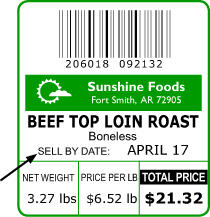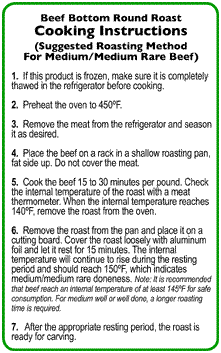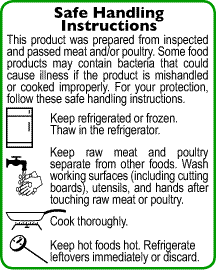| The food label on packaged beef provides a variety of information designed to make shopping as easy as possible. The label provides the following information depending on the type of beef product that is purchased: |
|
Description of Beef Cut
 The label on raw beef cuts contains the name of the primal cut the beef was taken from, the name of the retail or market ready cut, a short description (bone-in or boneless), the total weight, and cost per pound. If you are familiar with the different beef cuts, having the name of the cut on the label will help you determine if it is the proper leanness and/or tenderness for the type of recipe that you have planned. The label on raw beef cuts contains the name of the primal cut the beef was taken from, the name of the retail or market ready cut, a short description (bone-in or boneless), the total weight, and cost per pound. If you are familiar with the different beef cuts, having the name of the cut on the label will help you determine if it is the proper leanness and/or tenderness for the type of recipe that you have planned.
The name of the cut and whether it is bone-in or boneless will help you determine the quantity to buy according to the weight contained in the packages. A boneless cut will contain more servings than the bone-in cut, so it is important to take this into consideration when determining your needs. A bone-in cut may be lower in cost per pound, but when determining your best value, you should compare cost per serving. Another important point to consider is that the bone and fat help give beef great flavor and tenderness, so it may be worth paying a little extra per serving for the bone-in cut. To determine the cost per serving, use the following equation:
cost per pound / # of servings per pound = cost per serving
|
|
 Sell-By Date Sell-By Date
Packaged fresh beef will have a "sell-by date" printed on the food label, which represents the last day recommended for selling the product. Generally the store will pull any products left on the shelf the day of the "sell-by date". If the meat is properly refrigerated, it will remain fresh up to three days after the "sell-by date" but if it is not to be used within that time, it should be frozen. Some labels may have a "use-by date" rather than a "sell-by date", which indicates the meat should be cooked or frozen by that date. |
|
Fully Cooked/Ready-to-Eat/Heat and Eat
Some beef products are precooked, so the food label will indicate that the product is "fully cooked" or "ready-to-eat". A product such as beef luncheon meat is ready-to-eat, but requires refrigeration and beef jerky is ready-to-eat, but it can be stored at room temperature. Other products, such as canned goods, are precooked, but taste much better if they are heated before they are consumed. These products are known as "heat and eat". |
|
Nutritional Labeling
All commercially prepared and packaged beef products are required to provide nutritional information on the food label. Raw meat cuts in a food store or butcher shop are exempt from this requirement. The nutritional information shown on the label includes calories, fat and cholesterol content, protein, fiber, sugars, sodium, and various vitamins and minerals. |
|
 Cooking Instructions Cooking Instructions
If a product is not fully cooked or ready-to-eat, the label may provide information for proper cooking. |
|
 Safe Handling Instructions Safe Handling Instructions
The food label on raw beef or beef that is not fully cooked, will also contain food safety and handling instructions, which are required by the USDA. |
|
Some packaged beef that is labeled "lean" may simply refer to the fact that the excess fat has been trimmed from the beef and may not indicate that the cut of beef is actually a lean cut. If you purchase cuts from the tenderloin or round, you can be sure that they are lean. The tenderloin will not only be lean, but it will be very tender and very expensive. Although round cuts are lean, they are not naturally tender, but they are much more affordable. Proper preparation and cooking helps to tenderize them.
Much of the beef intended for stewing is simply labeled "stew meat" without describing the cut from which the beef was obtained. In most cases, the meat is taken from tougher cuts such as the bottom round, brisket, or plate. | |

